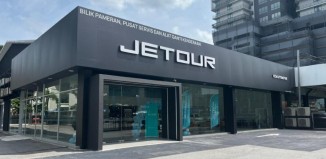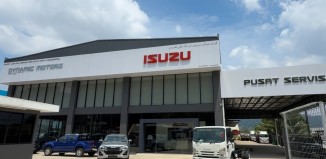New Toyota Rush Launched In Malaysia
 UMW Toyota Motor (UMWT) has launched the new Toyota Rush in Malaysia. This second generation 7-seater SUV will be locally assembled by Perodua, under contract (incidentally the Indonesia version is assembled by PT Astra Daihatsu), and deliveries to buyers are expected to happen in early 2019.
UMW Toyota Motor (UMWT) has launched the new Toyota Rush in Malaysia. This second generation 7-seater SUV will be locally assembled by Perodua, under contract (incidentally the Indonesia version is assembled by PT Astra Daihatsu), and deliveries to buyers are expected to happen in early 2019.
There are two variants available for the Rush – the 1.5 G and 1.5 S, with estimated retail prices of RM93,000 and RM98,000 respectively. Body colour choices are the practically named White, Silver Metallic, Dark Gray Metallic, Blue Metallic and Dark Green Metallic. All authorised Toyota showrooms are now accepting bookings for the Rush and it will be available in the showrooms starting January 2019.
 Both variants run on the familiar 1.5L 2NR-VE dual VVT-i engine paired with a 4-speed automatic gearbox, producing 105 PS and 136 Nm for the rear wheels (tyre size is 215/60 R17). The rear-wheel drive configuration allows the Rush to have a small turning radius of 5.2 metres. There is also the automatic stop-start function to improve fuel consumption; UMWT claims average consumption can be as good as 15.6 km per litre.
Both variants run on the familiar 1.5L 2NR-VE dual VVT-i engine paired with a 4-speed automatic gearbox, producing 105 PS and 136 Nm for the rear wheels (tyre size is 215/60 R17). The rear-wheel drive configuration allows the Rush to have a small turning radius of 5.2 metres. There is also the automatic stop-start function to improve fuel consumption; UMWT claims average consumption can be as good as 15.6 km per litre.
 Both Rush variants also get LED reflector headlights, LED tail lights and stop light, rear spoiler, roof rails, aero kit, electric power steering, smart entry and start, automatic climate control with rear blower, driver’s side sun visor with vanity mirror and lamp, Toyota AutoTag for toll card, 6.8″ AVX touchscreen infotainment system with phone mirroring function and six speakers, two USB charging ports, two accessory connectors, digital video recorder, panoramic view monitor, and a whopping thirteen cup holders.
Both Rush variants also get LED reflector headlights, LED tail lights and stop light, rear spoiler, roof rails, aero kit, electric power steering, smart entry and start, automatic climate control with rear blower, driver’s side sun visor with vanity mirror and lamp, Toyota AutoTag for toll card, 6.8″ AVX touchscreen infotainment system with phone mirroring function and six speakers, two USB charging ports, two accessory connectors, digital video recorder, panoramic view monitor, and a whopping thirteen cup holders.
For safety, the Rush is equipped with Anti-lock Braking System, Electronic Brake-force Distribution, Brake Assist, Emergency Stop Signal, Vehicle Stability Control, Traction Control, Hill-start Assist Control, Blind Spot Monitor, Rear Cross Traffic Alert, and six airbags. The Rush is also rated 5 stars by ASEAN NCAP for both the adult and child occupant protection categories.
The higher spec’d 1.5 S adds on automatic headlamps, front fog lamps, leather steering wheel with controls for audio and telephone, leather seats, and Pre-collision System that includes pre-collision warning, pre-collision braking, front departure alert, and pedal mis-operation control.
 The seating configuration is 2-3-2, with the second row featuring 60:40 split-fold, slide and recline, as well as a one-touch tumble mechanism for easier access to the third row. The third row splits 50:50 and can tumble and fold in the same ratio, and offers greater carrying and seating flexibility. With the third row folded down, you have 217 litres of cargo space, and when the third row is tumbled forward, that expands to 514 litres.
The seating configuration is 2-3-2, with the second row featuring 60:40 split-fold, slide and recline, as well as a one-touch tumble mechanism for easier access to the third row. The third row splits 50:50 and can tumble and fold in the same ratio, and offers greater carrying and seating flexibility. With the third row folded down, you have 217 litres of cargo space, and when the third row is tumbled forward, that expands to 514 litres.
First Impressions
 We had a go with the Rush on a drive around MAEPS, Cyberjaya and Putrajaya to get a feel of the vehicle after the launch. While the power numbers don’t look impressive on paper, it was sufficient to get the Rush going and keep pace with traffic. The gearing didn’t feel deficient and was fairly quick to downshift to maintain the momentum. We did have to rev it a little aggressively on some stretches but the engine felt robust albeit a little loud. There was also a short stint on sandy terrain where we had a bit of fun with stability control switched off. And despite all the idling and driving (we didn’t treat it as a frugal run), the average consumption hovered around 9 km per litre.
We had a go with the Rush on a drive around MAEPS, Cyberjaya and Putrajaya to get a feel of the vehicle after the launch. While the power numbers don’t look impressive on paper, it was sufficient to get the Rush going and keep pace with traffic. The gearing didn’t feel deficient and was fairly quick to downshift to maintain the momentum. We did have to rev it a little aggressively on some stretches but the engine felt robust albeit a little loud. There was also a short stint on sandy terrain where we had a bit of fun with stability control switched off. And despite all the idling and driving (we didn’t treat it as a frugal run), the average consumption hovered around 9 km per litre.
 The third row seat was not too uncomfortable although the knees of someone of 178 cm height will be pushed against the second row’s backrest. It’s passable for tall adults on short trips but they’re more suited for the shorter passengers when it comes to long drives. On the upside, all seats can recline. The rear suspension is 5-link with coil springs and lateral rod and performed well to dampened most bumps and not make the rear-most passenger carsick. The roof-mounted air blower helps cool the rear rows quite quickly by accelerating the air blown from a dedicated vent on the dashboard. It may be a little loud on its highest speed setting but it wasn’t annoying.
The third row seat was not too uncomfortable although the knees of someone of 178 cm height will be pushed against the second row’s backrest. It’s passable for tall adults on short trips but they’re more suited for the shorter passengers when it comes to long drives. On the upside, all seats can recline. The rear suspension is 5-link with coil springs and lateral rod and performed well to dampened most bumps and not make the rear-most passenger carsick. The roof-mounted air blower helps cool the rear rows quite quickly by accelerating the air blown from a dedicated vent on the dashboard. It may be a little loud on its highest speed setting but it wasn’t annoying.
The dashboard and interior trim feature plastics of contrasting colours. They may be moulded plastics with faux stitching but they break the monotony and at a glance, don’t look too bad.
Gallery:























































